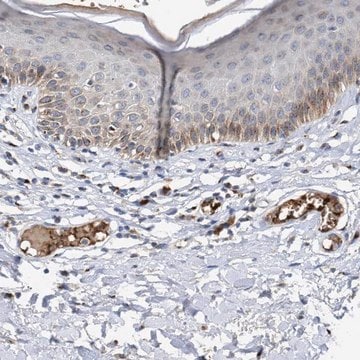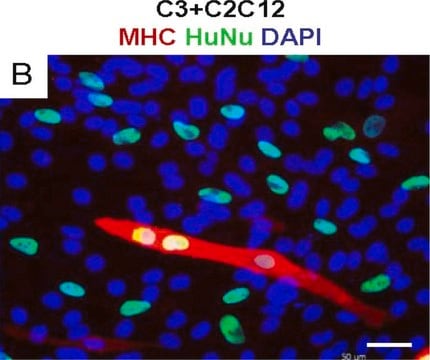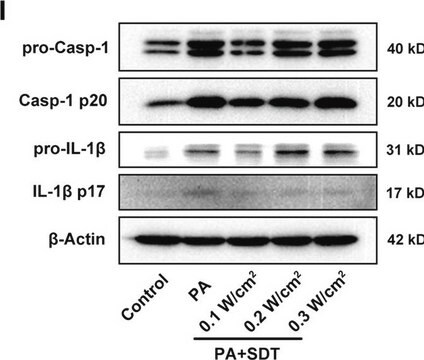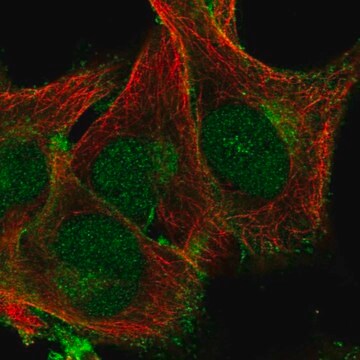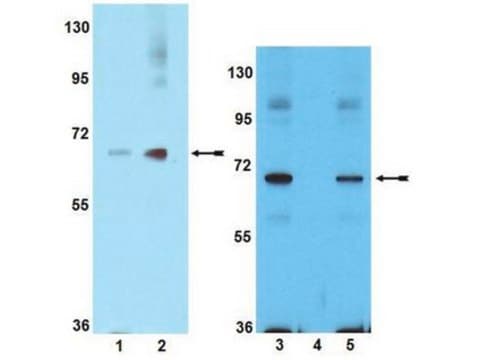推薦產品
生物源
mouse
品質等級
抗體表格
purified immunoglobulin
抗體產品種類
primary antibodies
無性繁殖
4D1.1, monoclonal
物種活性
human, rat
技術
immunohistochemistry: suitable (paraffin)
western blot: suitable
同型
IgG2bκ
NCBI登錄號
UniProt登錄號
運輸包裝
wet ice
目標翻譯後修改
unmodified
基因資訊
human ... FIS1(51024)
一般說明
FIS1 or TTC11, or FIS1 homolog (hFis1), or Tetratricopeptide repeat protein 11 (TPR repeat protein 11) or Mitochondrial fission 1 protein is an interesting member of mitochondrial essential proteins. FIS1 is encoded by the nuclear gene FIS1 and is a key player in mitochondrial dynamics. In eukaryotic cells, the shape of mitochondria can be tuned to various physiological conditions by a balance of fusion and fission processes termed mitochondrial dynamics. Mitochondrial dynamics control not only the morphology but also the function of mitochondria, and therefore is crucial in many aspects of a cell′s life. Thus there is a dynamic balance between fission and fusion events that can promote health and normal cell growth or when dysfunctional mitochondrial dynamics have been implicated in a variety of human diseases including cancer. Human FIS1 a mitochondrial, outer membrane localized, adaptor protein that is critical to recruiting the cellular machinery needed for mitochondrial fission or fusion. FIS1 is inserted into the mitochondrial outer membrane via a C-terminal transmembrane domain that, along with a short basic segment, is essential for its targeting to the mitochondria. Overexpression of FIS1 in human cells causes mitochondrial fragmentation and aggregation. FIS1 interacts with the dynamin-related GTPase DLP1/DRP1, and along with other adaptor proteins such as MDV1, MFF, and MiD, the dynamin-related proteins form spirals around constricted sites on mitochondria and assist in the fission of it. In addition to mitochondria, FIS1 also mediates peroxisome fission via the interaction with DLP1 as well. EMD-Millipore’s Anti-FIS1 rabbit polyclonal antibody has been tested in western blot on HeLa cell extracts and in immunohistochemistry on human brain tissue sections.
免疫原
GST-tagged recombinant protein corresponding to Human FIS1.
應用
Immunohistochemistry Analysis: A 1:250 dilution from a representative lot detected FIS1 in human and rat cerebral cortex tissue.
Research Category
Neuroscience
Neuroscience
Neuroscience
Neuroscience
Research Sub Category
Neurodegenerative Diseases
Apoptosis - Additional
Neurodegenerative Diseases
Apoptosis - Additional
This Anti-FIS1 Antibody, Clone 4D1.1 is validated for use in Western Blotting and Immunohistochemistry (Paraffin) for the detection of FIS1.
品質
Evaluated by Western Blotting in Raji cell lysate.
Western Blotting Analysis: A 1 µg/mL dilution of this antibody detected FIS1 in 10 µg of Raji cell lysate.
Western Blotting Analysis: A 1 µg/mL dilution of this antibody detected FIS1 in 10 µg of Raji cell lysate.
標靶描述
~ 17 kDa observed
外觀
Protein G Purified
Format: Purified
Purified mouse monoclonal IgG2bκ in buffer containing 0.1 M Tris-Glycine (pH 7.4), 150 mM NaCl with 0.05% sodium azide.
儲存和穩定性
Stable for 1 year at 2-8°C from date of receipt.
其他說明
Concentration: Please refer to lot specific datasheet.
免責聲明
Unless otherwise stated in our catalog or other company documentation accompanying the product(s), our products are intended for research use only and are not to be used for any other purpose, which includes but is not limited to, unauthorized commercial uses, in vitro diagnostic uses, ex vivo or in vivo therapeutic uses or any type of consumption or application to humans or animals.
未找到適合的產品?
試用我們的產品選擇工具.
儲存類別代碼
12 - Non Combustible Liquids
水污染物質分類(WGK)
WGK 1
閃點(°F)
Not applicable
閃點(°C)
Not applicable
分析證明 (COA)
輸入產品批次/批號來搜索 分析證明 (COA)。在產品’s標籤上找到批次和批號,寫有 ‘Lot’或‘Batch’.。
Naresh C Bal et al.
The Journal of biological chemistry, 291(33), 17247-17257 (2016-06-15)
Skeletal muscle has been suggested as a site of nonshivering thermogenesis (NST) besides brown adipose tissue (BAT). Studies in birds, which do not contain BAT, have demonstrated the importance of skeletal muscle-based NST. However, muscle-based NST in mammals remains poorly
我們的科學家團隊在所有研究領域都有豐富的經驗,包括生命科學、材料科學、化學合成、色譜、分析等.
聯絡技術服務
